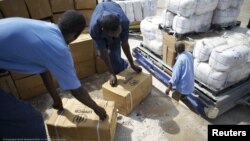NAIROBI - As the United Nations prepares to mark World Refugee Day Wednesday, the U.N. refugee agency is struggling to put exact figures to the number of internally displaced people inside Somalia. The country's displaced population is constantly on the move in search of humanitarian assistance and a peaceful environment.
The U.N. refugee agency, or UNHCR, said there are about 1.35 million displaced people inside Somalia. But the number is only an estimate.
Speaking to journalists in Nairobi, the U.N. High Commissioner for Refugees representative for Somalia, Bruno Geddo, said his agency has faced a daunting task to make an accurate count.
He said displaced families move frequently, and satellite images pick up only temporary, makeshift shelters that remain empty most of the time, except when there is an aid distribution.
"Satellite imagery estimates, satellite cannot estimate how many people are living actually in each makeshift shelter," said Geddo. "They can only count the shelters but cannot confirm how many people are inside. "And therefore it's very imprecise measure of science, [a] very approximate rough estimation.”
Geddo notes humanitarian aid agencies use the satellite imagery for a working figure to provide assistance to the displaced, but not exact figures of the population in a given area.
He said the refugee agency is planning to carry out its own ground surveys in the Afgoye corridor - home to tens of thousands of displaced Somalis - to try to determine the exact number of Somalis in the 30-kilometer stretch.
“We will try to get access into Afgoye corridor, to do ground surveys, to try and see if we can do better than satellite imagery alone," said Geddo. "But it will remain a challenge because the gatekeepers will continue to provide figures which do not correspond to reality.”
The gatekeepers, in some areas, are al-Shabab militants who still control parts of southern and central Somalia.
It may be hard to get an exact number of people displaced in a given area, as the frontline of the military offensive against al-Shabab shifts from one region to the other.
For the last few months African Union forces have been announcing their offensives to give people time to get out of areas under military operations.
According to the UNHCR, displaced people have cited a number of reasons why they left their villages and towns. Some of the IDPs expressed fear of being forcibly recruited to fight for al-Shabab. The rebel group also increased taxation on the already-suffering population in areas still under its control, especially the Juba and Shabelle regions.
The group has been dealt a blow both militarily by the African Union forces and Somali government fighters, and financially after losing vast amounts of land it once controlled.
The U.N. refugee agency, or UNHCR, said there are about 1.35 million displaced people inside Somalia. But the number is only an estimate.
Speaking to journalists in Nairobi, the U.N. High Commissioner for Refugees representative for Somalia, Bruno Geddo, said his agency has faced a daunting task to make an accurate count.
He said displaced families move frequently, and satellite images pick up only temporary, makeshift shelters that remain empty most of the time, except when there is an aid distribution.
"Satellite imagery estimates, satellite cannot estimate how many people are living actually in each makeshift shelter," said Geddo. "They can only count the shelters but cannot confirm how many people are inside. "And therefore it's very imprecise measure of science, [a] very approximate rough estimation.”
Geddo notes humanitarian aid agencies use the satellite imagery for a working figure to provide assistance to the displaced, but not exact figures of the population in a given area.
He said the refugee agency is planning to carry out its own ground surveys in the Afgoye corridor - home to tens of thousands of displaced Somalis - to try to determine the exact number of Somalis in the 30-kilometer stretch.
“We will try to get access into Afgoye corridor, to do ground surveys, to try and see if we can do better than satellite imagery alone," said Geddo. "But it will remain a challenge because the gatekeepers will continue to provide figures which do not correspond to reality.”
The gatekeepers, in some areas, are al-Shabab militants who still control parts of southern and central Somalia.
It may be hard to get an exact number of people displaced in a given area, as the frontline of the military offensive against al-Shabab shifts from one region to the other.
For the last few months African Union forces have been announcing their offensives to give people time to get out of areas under military operations.
According to the UNHCR, displaced people have cited a number of reasons why they left their villages and towns. Some of the IDPs expressed fear of being forcibly recruited to fight for al-Shabab. The rebel group also increased taxation on the already-suffering population in areas still under its control, especially the Juba and Shabelle regions.
The group has been dealt a blow both militarily by the African Union forces and Somali government fighters, and financially after losing vast amounts of land it once controlled.






